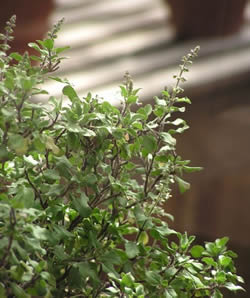Holy Basil Ocimum sanctum
- Common Names
- Holy Basil , Tulsi, Tulasi, Indian Basil
- Botanical Name
- Ocimum sanctum
- Syn. Ocimum tenuiflorum
- Family
- LAMIACEAE
Medicinal Uses & Benefits of Holy Basil
![]() How to Use|
Side Effects |
Plant & Garden|
Folklore
How to Use|
Side Effects |
Plant & Garden|
Folklore
- Medicinal Uses: * Ayurvedic
* Colds
* Congestion
* Flu
* Herbal Teas
* IBS
* Memory/Focus
* Nausea
* Stress
- Properties: * Adaptogens * Antibacterial * Antitussive * Aromatic * Carminative * Demulcent * Diaphoretic * Diuretic * emetic * Febrifuge * Insect repellents * Laxative * Parturient * Stomachic
- Parts Used: Leaves, essential oil
- Constituents: ascorbic-acid, beta-carotene , beta-sitosterol, carvacrol, eugenol, linoleic-acid, methyl-chavicol , oleic-acid, mucilage , palmitic-acid , saponins,stearic-acid, tannin
How to Use: Holy Basil
“Oh, Narada! Every house, every village, every forest, wherever the plant of Tulsi is grown, their misery, fear, disease and poverty do not exist. Tulsi in all aspects and places is holier than holy. Where the breeze blows through Tulsi plants, it spreads Tulsi's fragrance making the surrounding area pious and pure ”
Shiva
Holy Basil has been used for thousands of years in the traditional medicinal of India, Ayurveda. Known to Hindus as Tulsi the plant is also used in religious ceremonies. Holy Basil is used in Ayurvedic medicine for common colds, headaches, stomach disorders, inflammation, heart disease, various forms of poisoning, and malaria.
Holy Basil is an excellent example of an adaptogen herb that can help relieve the stress of modern living. Oxidation caused by free radicals and chronic inflammation are potent sources of mind and body stress. Sipping tulsi-leaf and other green leaf teas let us "borrow" some of the adaptogenic and antioxidant chemicals that plants produce when making oxygen in their leaves. The phytochemical ursolic acid has a pronounced anti-inflammatory action and is a selective COX-2-inhibitor. It is similar to green tea in its anti-tumor and anti-ulcerative properties. 3 Many clinical studies now support the folklore traditions of holy basil as a safe neuroprotective, that protects the brain against degenerative diseases. Citations
Preparation Methods & Dosage :Teas, dried powder, fresh leaf, or mixed with ghee. Holy Basil essential oil is used in skin preparations and cosmetics.
Holy Basil Remedies
Ayurvedic Medicine
 Tulsi is sweet, pungent, astringent, and healing with a pungent vipaka. It increases pitta, and decreases vata and kapha. Tulsi is good for fever, cough, and breathlessness.
2
Tulsi is sweet, pungent, astringent, and healing with a pungent vipaka. It increases pitta, and decreases vata and kapha. Tulsi is good for fever, cough, and breathlessness.
2
Plant Description
The holy basil plant looks very similar to other basils, with slender leaves, hairy purplish stems, and purple flower bracts. The leaves and the essential oil have a light musky scent with a warming hint of mint and cloves. It has a refreshing, pleasant smell, so keeping a plant in your home can purify the air.
Regional Traditions :Ayurvedic *
How to Grow Holy Basil
Bush basil, perennial in frost free zones, or can be over-wintered indoors or grown as an annual. Does best in full sun and can be grown in pots.
History and Traditions & Folklore
Hindus believe holy basil is pervaded by the essence of Vishnu and his wife Lakshmi, and is itself worshipped daily as a deity. The plant is considered especially a woman's deity, as an embodiment of Lakshmi, or of Rama's wife Sita, or of Krishna's wife Rukmini. Women worship it with offerings of rice and flowers.Sir James George Frazer The Golden Bough. A Study in Magic and Religion. II. Part 1 (1890).
- Thomas M. Newmark. "Beyond Aspirin" SCB, (2000) Ocimum sanctum, holy basil, contains the phytonutrient ursolic acid which is specifically recognized for its COX-2 inhibitory effects. Derivatives of oleanolic acid and ursolic acid possess potential anti-inflammatory and cancer-preventing activity related to their inhibition of COX-2 pp63-64
- Usha Lad & Dr. Vasant Lad. "Ayurvedic Cooking for Self Healing" The Ayurvedic Press, (2006) Tulsi is good for fever, cough, and breathlessness.
- Duke JA.. . Basil as the Holy Hindu Highness , American Botanical Council. Altern Complement Ther, (February 2008): ,

- . Healing Herbs , Prevention Magazine, (Jun 2007): Several animal studies back holy basil as effective at reducing stress by increasing adrenaline and noradrenaline and decreasing serotonin. Holy basil is also being investigated as an aid in breast cancer treatment., pp224













